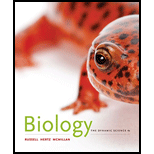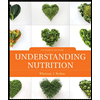
Concept explainers
Introduction:
Plant nutrition includes macronutrients and micronutrients. The plant is incapable of completing a regular life-cycle in the absence of these nutrients, as these elements are an essential part of plant constituents/ metabolites. There are several important nutrients from which plants must obtain their growing media such as, macronutrients and micronutrients. Some common example of the macronutrients include, calcium, hydrogen, carbon, nitrogen, and magnesium.
Answer to Problem 1TYK
Correct answer:
Macronutrients and micronutrients are needed for plant development and nutrition. They take essential nutrients from the soil through their roots, and take oxygen through their leaves. All macronutrient and micronutrient perform distinct functions for their proper growth and development.
Explanation of Solution
Justification/explanation for the correct answer:
The statement that says, “They are essential for normal growth and development” is applicable to the plant micronutrients. This is because the deficiency of these micronutrients is known to cause stunting, discoloration, deformity, distress, and even death of plants.
Hence, option (e) is correct.
Explanation for the incorrect answer:
Option (a) is, the statement “They typically are not available in loams” is not applicable to plant micronutrients. Loam is the soil made up of sand size particles greater than 63 micrometers, silt size particles greater than 2 micrometers, and a minor quantity of clay, size less than 2 micrometers. Loam soil has high amount of minerals. They contain more moisture, nutrients, and hummus, and have better infiltration of air and water. Loam soil is suitable for growing most varieties of plants. The correct statement is “They typically are available in loams.” So, it is an incorrect option.
Option (b) is, the statement “They cannot be replaced by the use of fertilizers” is not applicable to the plant micronutrients. Fertilizers are substances of natural/ synthetic nature that are provided to the soil or to the plants, to supply essential plant nutrients that are necessary for their growth. Fertilizers may be natural or industrially synthesized. The correct statement is “They can be replaced by the use of fertilizers.” So, it is an incorrect option.
Option (c) is, the statement “They appear early on the periodic chart as compared to macronutrients” is not applicable to the plant micronutrients. There are several important nutrients that plants obtain from their growing medium, like macronutrients and micronutrients. It becomes clear from the periodic table that the plant micronutrients do not appear early on the periodic chart as compared to macronutrients. So, the correct statement is “They appear later on the periodic chart as compared to macronutrients”. So, it is an incorrect option.
Option (d) is, the statement “They are required in large amounts for normal
Hence, options (a), (b), (c), and (d) are incorrect.
Thus, it can be concluded that the statement (e) is true according to the reason provided and the statements (a), (b), (c), and (d) are false.
Want to see more full solutions like this?
Chapter 35 Solutions
Biology: The Dynamic Science (MindTap Course List)
- Please indentify the unknown organismarrow_forwardPlease indentify the unknown organismarrow_forward5G JA ATTC 3 3 CTIA A1G5 5 GAAT I I3 3 CTIA AA5 Fig. 5-3: The Eco restriction site (left) would be cleaved at the locations indicated by the arrows. However, a SNP in the position shown in gray (right) would prevent cleavage at this site by EcoRI One of the SNPs in B. rapa is found within the Park14 locus and can be detected by RFLP analysis. The CT polymorphism is found in the intron of the Bra013780 gene found on Chromosome 1. The Park14 allele with the "C" in the SNP has two EcoRI sites and thus is cleaved twice by EcoRI If there is a "T" in that SNP, one of the EcoRI sites is altered, so the Park14 allele with the T in the SNP has only one EcoRI site (Fig. 5-3). Park14 allele with SNP(C) Park14 allele with SNPT) 839 EcoRI 1101 EcoRI 839 EcoRI Fig. 5.4: Schematic restriction maps of the two different Park14 alleles (1316 bp long) of B. rapa. Where on these maps is the CT SNP located? 90 The primers used to amplify the DNA at the Park14 locus (see Fig. 5 and Table 3 of Slankster et…arrow_forward
- From your previous experiment, you found that this enhancer activates stripe 2 of eve expression. When you sequence this enhancer you find several binding sites for the gap gene, Giant. To test how Giant interacts with eve, you decide to remove all of the Giant binding sites from the eve enhancer. What results do you expect to see with respect to eve expression?arrow_forwardWhat experiment could you do to see if the maternal gene, bicoid, is sufficient to form anterior fates?arrow_forwardYou’re curious about the effect that gap genes have on the pair-rule gene, evenskipped (eve), so you isolate and sequence each of the eve enhancers. You’re particularly interested in one of the enhancers, which is just upstream of the eve gene. Describe an experimental technique you would use to find out where this particular eve enhancer is active.arrow_forward
- For short answer questions, write your answers on the line provided. To the right is the mRNA codon table to use as needed throughout the exam. First letter U บบบ U CA UUCPhe UUA UCU Phe UCC UUG Leu CUU UAU. G U UAC TV UGCys UAA Stop UGA Stop A UAG Stop UGG Trp Ser UCA UCG CCU] 0 CUC CUA CCC CAC CAU His CGU CGC Leu Pro CCA CAA Gin CGA Arg CUG CCG CAG CGG AUU ACU AAU T AUC lle A 1 ACC Thr AUA ACA AUG Mot ACG AGG Arg GUU GCU GUC GCC G Val Ala GAC Asp GGU GGC GUA GUG GCA GCG GAA GGA Gly Glu GAGJ GGG AACASH AGU Ser AAA1 AAG Lys GAU AGA CAL CALUCAO CAO G Third letter 1. (+7) Use the table below to answer the questions; use the codon table above to assist you. The promoter sequence of DNA is on the LEFT. You do not need to fill in the entire table. Assume we are in the middle of a gene sequence (no need to find a start codon). DNA 1 DNA 2 mRNA tRNA Polypeptide C Val G C. T A C a. On which strand of DNA is the template strand (DNA 1 or 2)?_ b. On which side of the mRNA is the 5' end (left or…arrow_forward3. (6 pts) Fill in the boxes according to the directions on the right. Structure R-C R-COOH OH R-OH i R-CO-R' R R-PO4 R-CH3 C. 0 R' R-O-P-OH 1 OH H R-C-H R-N' I- H H R-NH₂ \H Name Propertiesarrow_forward4. (6 pts) Use the molecule below to answer these questions and identify the side chains and ends. Please use tidy boxes to indicate parts and write the letter labels within that box. a. How many monomer subunits are shown? b. Box a Polar but non-ionizable side chain and label P c. Box a Basic Polar side chain and label BP d. Box the carboxyl group at the end of the polypeptide and label with letter C (C-terminus) H H OHHO H H 0 HHO H-N-CC-N-C-C N-C-C-N-GC-OH I H-C-H CH2 CH2 CH2 H3C-C+H CH2 CH2 OH CH CH₂ C=O OH CH2 NH2arrow_forward
 Biology: The Dynamic Science (MindTap Course List)BiologyISBN:9781305389892Author:Peter J. Russell, Paul E. Hertz, Beverly McMillanPublisher:Cengage Learning
Biology: The Dynamic Science (MindTap Course List)BiologyISBN:9781305389892Author:Peter J. Russell, Paul E. Hertz, Beverly McMillanPublisher:Cengage Learning Understanding Nutrition (MindTap Course List)Health & NutritionISBN:9781337392693Author:Eleanor Noss Whitney, Sharon Rady RolfesPublisher:Cengage Learning
Understanding Nutrition (MindTap Course List)Health & NutritionISBN:9781337392693Author:Eleanor Noss Whitney, Sharon Rady RolfesPublisher:Cengage Learning Biology (MindTap Course List)BiologyISBN:9781337392938Author:Eldra Solomon, Charles Martin, Diana W. Martin, Linda R. BergPublisher:Cengage Learning
Biology (MindTap Course List)BiologyISBN:9781337392938Author:Eldra Solomon, Charles Martin, Diana W. Martin, Linda R. BergPublisher:Cengage Learning Concepts of BiologyBiologyISBN:9781938168116Author:Samantha Fowler, Rebecca Roush, James WisePublisher:OpenStax College
Concepts of BiologyBiologyISBN:9781938168116Author:Samantha Fowler, Rebecca Roush, James WisePublisher:OpenStax College





